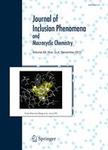版权所有:内蒙古大学图书馆 技术提供:维普资讯• 智图
内蒙古自治区呼和浩特市赛罕区大学西街235号 邮编: 010021

作者机构:KN Toosi Univ Technol Dept Chem Tehran Iran
出 版 物:《JOURNAL OF INCLUSION PHENOMENA AND MACROCYCLIC CHEMISTRY》 (J. Incl. Phenom. Macrocyclic Chem.)
年 卷 期:2013年第76卷第1-2期
页 面:47-54页
核心收录:
主 题:Complexation Temperature titration Enthalpy Entropy Porphyrin Organotin(IV) Iterative algorithm
摘 要:A novel, fast and easy single sample measurement has been developed based upon temperature dependence of equilibrium constant in order to determine the enthalpy and entropy changes of a complexation reaction using spectrophotometric temperature titration. The method can be used in determination of the formation constant and thermodynamic parameters of the solutions that there are difficulties in their titration where volatile compounds are studying. Knowledge of component spectra is not required for the analysis. The formation constants of the interactions of -di and tri-brominated meso-tetraphenylporphyrins, and meso-tetrakis(4-methylphenyl) and (4-methoxyphenyl) porphyrins with Me2SnCl2 and Bu2SnCl2, have been determined in range of 0-25 A degrees C utilizing van t Hoff relation, mass balance and equilibrium constant equations by an iterative least squares method with Delta H (0) as adjustable parameter. The outputs of analysis are the equilibrium constants, ligand and adduct spectral profiles, their concentrations as a function of temperature, the adjusted values of the standard enthalpy Delta H (0), and entropy Delta S (0) changes. The order of formation constants of the resulting 1:1 complexes decreased with increasing number of bromide substituents and increased with adding methyl and methoxy groups, and vary as H2T(4-CH3O)PP H2T(4-CH3)PP H2TPP H2TPPBr2 H2TPPBr3 and Me2SnCl2 Bu2SnCl2.